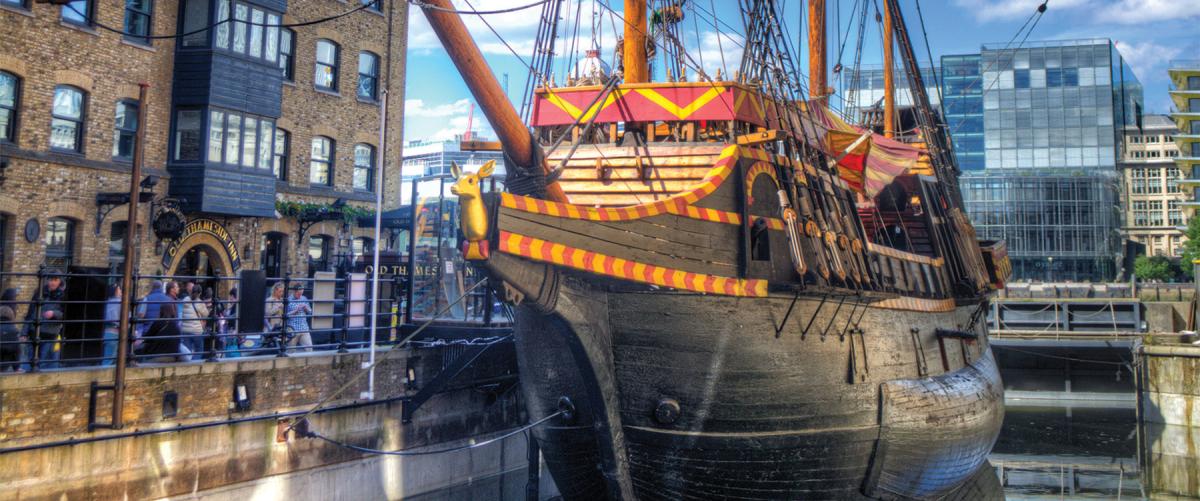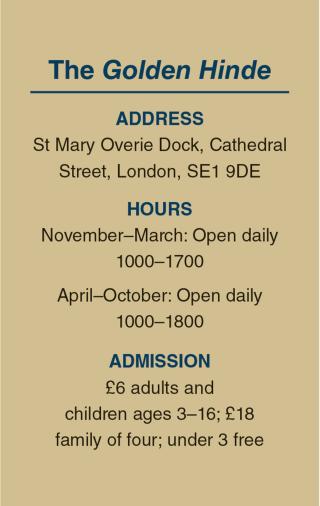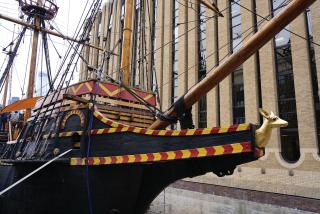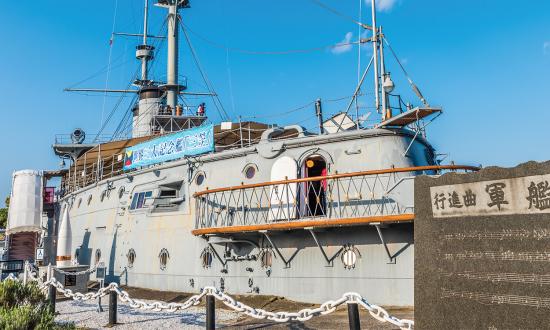On the south bank of the Thames River in London, close to London Bridge and the reconstruction of Shakespeare’s Globe Theatre, the 1973 replica of Francis Drake’s famous galleon the Golden Hinde welcomes visitors at St Mary Overie Dock. The first sight of the ship comes as a surprise, because she floats concealed between a pub and a multistory office building. However, as visitors round a corner, the ship’s three masts and the hull, colorfully painted in red and yellow, reveal themselves. Prominent on the prow is the gilded head of a hinde, or female red deer, clearly announcing that this is Drake’s famous treasure ship.
Perhaps the most amazing thing about the original Golden Hinde and her faithful replica is that both of these tiny vessels (102 feet long) successfully circumnavigated the globe. One returned in 1580 loaded with gold and silver, the other in 1979 with a treasure of pride and accomplishment.
The original Golden Hinde’s voyage of plunder and exploration began in 1577 when Francis Drake sailed from England with five ships and 164 men. His sailors thought they were bound for Egypt. Instead, Drake took them around Cape Horn and into the Pacific Ocean. Now down to only one ship, Drake raided unsuspecting Spanish towns and shipping along the west coast of South America in 1578.
His venture reached its height of success with the capture of the Spanish ship Nuestra Señora de la Concepción off the coast of Ecuador in March 1579. Among her riches were 26 tons of silver and 80 pounds of gold. It took his crew six days to transfer all the treasure to the Golden Hinde.
Drake then sailed north, probably as far as British Columbia, in hopes of returning to England via the Northwest Passage. When his search for it proved unsuccessful, he took the Golden Hinde to a harbor somewhere in California or Oregon for repairs. Realizing the Spanish would now be looking for him if he went south, he returned to England by sailing west across the Pacific and around Africa.
The Golden Hinde arrived in England in September 1580, almost three years after her departure. So immense was the treasure Drake had accumulated that it was said the crew had to make room for it by replacing the ship’s stone ballast with bricks of silver and gold.
The English were overjoyed with the Golden Hinde’s adventure and the riches she carried. Queen Elizabeth I immediately designated the ship a national treasure. Crowds of people paid admission to go aboard what was only the second vessel to circumnavigate the globe. To put her accomplishment in modern perspective, the Golden Hinde was the equivalent of a spacecraft that had gone to the moon and returned.
Drake’s voyage boosted England’s wealth and prestige at a time when the global balance of power was shifting. The Spanish claimed a vast empire that provided a seemingly endless source of gold and silver. At the same time, the English were building their sea power, making them a threat to Spanish dominance. The treasure Drake brought back enriched England’s treasury and earned respect for its people.
Elizabeth made Drake a knight; the ceremony was performed on the main deck of the Golden Hinde in April 1581. Spanish King Philip II was already outraged about Drake’s piracy. To avoid further angering him and to show French sympathy with England, Elizabeth arranged for the French ambassador to perform the dubbing ceremony using the Queen’s ceremonial state sword.
When the Spanish Armada sailed in 1588 to conquer England, a more prosperous and confident England defeated it. The Golden Hinde, however, did not participate in the fight against the Armada. The galleon remained in London, a symbol of national pride for more than 80 years until age and rot overcame her.
To commemorate the 400th anniversary of Drake’s believed landing in what would become San Francisco, a California consortium commissioned a replica of the Golden Hinde to be built at a shipyard in Devon, England. The replica faithfully matches the size and rigging of the original. Between 1974 and 1979 the replica Golden Hinde made her own circumnavigation that included appearing in the miniseries Shōgun.
Just as curious Elizabethans did, modern visitors can tour the entire ship. Interpretive labels and QR codes provide information about each of the vessel’s compartments and the equipment in them.
A visit begins on the main deck. Drake undoubtedly gave Elizabeth a tour of the Golden Hinde, guiding her forward to see, as visitors do today, the cramped foc’sle where some of the senior crew slept. The foc’sle also served as the ship’s galley.
Walking aft, today’s visitors enter a compartment interpreted as the armory, where there are several lethal-looking bladed weapons mounted on the bulkhead. The officers lived and slept here in hammocks. Aft of the armory is the great cabin, which the officers used for dining, meetings, and socializing. Drake apparently had no private cabin and slung a hammock with the rest of his officers.
Steep stairs in the armory lead down to the gun deck. The overhead is about four feet, and lucky will be the adult who does not bang their head into the low wooden beams at least once. Most of the crew of 80 lived and slept in this space. They shared it with the live animals that provided eggs, meat, and some milk during a voyage.
The Golden Hinde carried 14 cannon on the gun deck; the replica has 11. The rammers, swabs, and a worm used to service the gun are displayed nearby.
Going down one more deck, visitors enter the hold, where they can easily stand upright. While it looks large when empty, the hold would have been crammed full of food, water, and all the stores needed to sustain the crew on an around-the-world voyage.
Returning to the main deck, visitors can climb up a ladder to the poop deck, where the officers stood watch and the helmsman, eyeing the compass, steered with a whipstaff; today’s replica uses a wheel. The view from the helm is no longer of the sea ahead but into the ship’s illustrious past. A visit to the replica Golden Hinde provides a memorable connection to the skill, courage, and endurance of the mariners who sailed the world’s great oceans during the Elizabethan Age.









